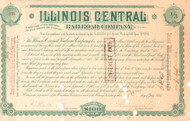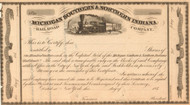Categories
Categories
- Home
- Railroad
- 1800's Railroads
- Northern Pacific Railroad share subscription circa 1864
Northern Pacific Railroad share subscription circa 1864
Product Description
Northern Pacific Railroad subscription certificate circa 1864
Nice railway certificate that comes in a pair from the ledger (two for the price of one). Unissued and not cancelled. Circa 1864 from issued examples. These were early versions of an Initial Public Offering (IPO). You get a sheet of two certificates (not perforated for separation).
The Northern Pacific Railway was a transcontinental railroad that operated across the northern tier of the western United States from Minnesota to the Pacific Coast. It was approved by Congress in 1864 and given nearly 40 million acres of land grants, which it used to raise money in Europe for construction. Construction began in 1870 and the main line opened all the way from the Great Lakes to the Pacific when former president Ulysses S. Grant drove in the final "golden spike" in western Montana on Sept. 8, 1883. The railroad had about 6800 miles of track and served a large area, including extensive trackage in the states of Idaho, Minnesota, Montana, North Dakota, Oregon, Washington and Wisconsin. In addition the company had an international branch to Winnipeg, Manitoba, Canada. The main activities were shipping wheat and other farm products, cattle, timber and minerals; bringing in consumer goods, transporting passengers; and selling land. The company was headquartered first in Brainerd, Minnesota, then in Saint Paul, Minnesota. It had a tumultuous financial history, and in 1970 it merged with other lines to form the Burlington Northern Railroad.
The first survey for a northern route to the Pacific was conducted by the War Department in 1853. The Northern Pacific Railroad Company was organized in 1864 with Josiah Perman as president. Construction began at Carlton, Minnesota, in February 1870, with an initial operation of 125 miles. That same year, construction began at Kalama, Washington Territory, near Portland, Oregon, and that line was extended to New Tacoma, Washington Territory, by 1873. The company was reorganized in the wake of financial troubles in 1875. The western and eastern lines joined at Gold Creek, Montana, in 1883. The real completion date was 1888 when the tunnel through Stampede Pass, Washington, was opened, replacing a switchback line over that pass. The company was reorganized for a second time in 1896 as the Northern Pacific Railway Company.
For the next six years, backers of the road struggled to find financing. Though John Gregory Smith succeeded Perham as president on January 5, 1865, groundbreaking did not take place until February 15, 1870, at Carlton, Minnesota, 25 miles west of Duluth, Minnesota. The backing and promotions of famed financier Jay Cooke in the summer of 1870 brought the first real momentum to the company.
Over the course of 1871, the Northern Pacific pushed westward from Minnesota into present-day North Dakota. Surveyors and construction crews had to maneuver through swamps, bogs, and tamarack forests. The difficult terrain and insufficient funding delayed by six months the construction phase in Minnesota. The NP also began building its line north from Kalama, Washington Territory, on the Columbia River outside of Portland, Oregon, towards Puget Sound. Four small construction engines were purchased, the Minnetonka, Itaska, Ottertail and St. Cloud, the first of which was shipped to Kalama by ship around Cape Horn. In Minnesota, the Lake Superior and Mississippi Railroad completed construction of its 155-mile line stretching from Saint Paul to Lake Superior at Duluth in 1875. It was leased to the Northern Pacific the following year, and was eventually absorbed by the Northern Pacific.
The Northern Pacific Railroad reached Fargo, Dakota Territory, (N.D.) early in June of 1872. The following year, in June 1873, the N.P. reached the shores of the Missouri River, at Edgerton (Bismarck) D.T. In the west, the track extended 25 miles north from Kalama. Surveys were carried out in North Dakota protected by 600 troops under General Winfield Scott Hancock. Headquarters and shops were established in Brainerd, Minnesota, a town named for the President John Gregory Smith's wife Anna Elizabeth Brainerd.
In 1886, the company put down 164 miles of main line across North Dakota, with an additional 45 miles in Washington. On November 1, General George Washington Cass became the third president of the company. Cass had been a vice-president and director of the Pennsylvania Railroad, and would lead the Northern Pacific through some of its most difficult times. In 1886 the Northern Pacific also opened colonization offices in Germany and Scandinavia, attracting farmers with cheap package transportation and purchase deals. The success of the NP was based on the abundant crops of wheat and other grains and the attraction to settlers of the Red River Valley along the Minnesota-North Dakota border between 1881 and 1890.
In 1873, Northern Pacific made impressive strides before a terrible stumble. Rails from the east reached the Missouri River on June 4. After several years of study, Tacoma, Washington, was selected as the road's western terminus on July 14. However, for the past three years the financial house of Jay Cooke and Company had been throwing money into the construction of the Northern Pacific.
Cooke had little success in marketing the bonds in Europe and overextended his house in meeting overdrafts of the mounting construction costs. Cooke overestimated his managerial skills and failed to appreciate the limits of a banker's ability to be also a promoter, and the danger of freezing his assets in the bonds of the Northern Pacific. Cooke and Company went bankrupt on September 18, 1873. Soon the Panic of 1873 engulfed the United States, beginning an economic depression that ruined or nearly paralyzed newer railroads.
The Northern Pacific, however, survived bankruptcy that year, due to austerity measures put in place by President Cass. In fact, working with last-minute loans from Director John C. Ainsworth of Portland, the Northern Pacific completed the line from Kalama to Tacoma before the end of the year. On December 16, the first steam train arrived in Tacoma. By 1874, however, the company was moribund. Northern Pacific slipped into its first bankruptcy on June 30, 1875.
In 1877, construction resumed in a small way. Northern Pacific pushed a branch line southeast from Tacoma to Puyallup, Washington and on to the coal fields around Wilkeson, Washington. Much of the coal was destined for export through Tacoma to San Francisco, California, where it would be thrown into the fireboxes of Central Pacific Railroad steam engines.
This small amount of construction was one of the largest projects the company would undertake in the years between 1874 and 1880. That same year the company built a large shop complex at Edison, Washington. For many years the shops at Brainerd and Edison would carry out heavy repairs and build equipment for the railroad. On May 24, 1879, Vermont lawyer Frederick Billings became the president of the company. Billings' tenure would be short but ferocious. Reorganization, bond sales, and improvement in the U.S. economy allowed Northern Pacific to strike out across the Missouri River by letting a contract to build 100 miles of railroad west of the river. The railroad's new-found strength, however, would be seen as a threat in certain quarters.
 Loading... Please wait...
Loading... Please wait... 








